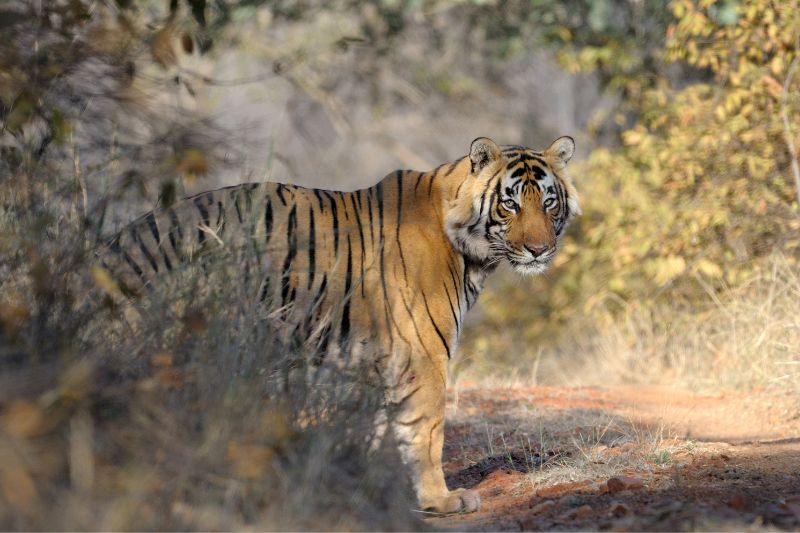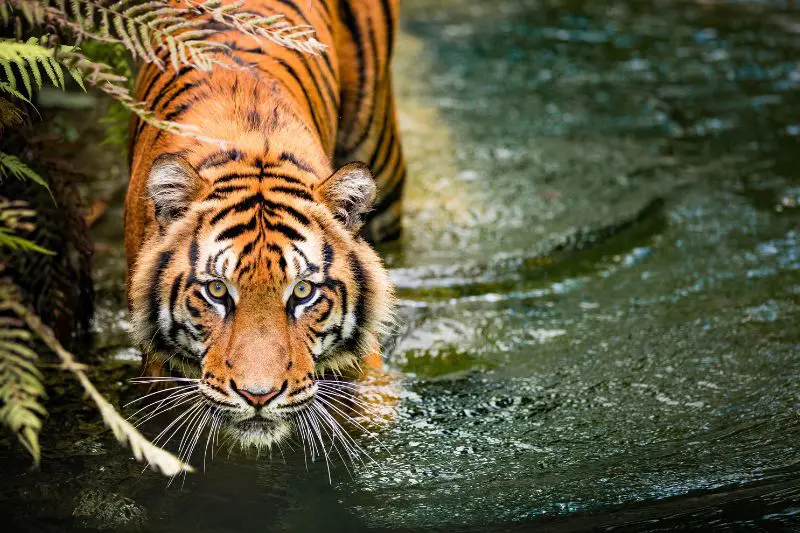Tigers are some of the most beautiful creatures in the world, and seeing one in the wild is an unforgettable experience that many wildlife enthusiasts dream of. Fortunately, there are several places around the world where you can witness these majestic creatures in their natural habitat.
In this guide, we’ll explore some of the best places to see tigers in the wild, from the lush forests of India to the dense jungles of Nepal and Bhutan.
Whether you’re an avid wildlife photographer or just looking for a once-in-a-lifetime adventure, these destinations offer unique opportunities to observe these magnificent creatures. So, let’s dive in and find out where to see tigers in the wild!
Bandhavgarh National Park, India
Bandhavgarh National Park was declared a national park in 1968 and, since then, has been widely considered to be one of the best places to see tigers in the wild.
With a relatively small footprint of 105 km2, it’s certainly one of the smallest national parks in India. And while you may think a small tiger reserve gives you a lower chance of seeing tigers, quite the opposite is true. Bandhavgarh is home to a dense population of tigers, making it one of the most reliable places to see them.
In addition to tigers, Bandhavgarh National Park is also home to a variety of other wildlife, including leopards, sloth bears, wild dogs, and many species of deer, antelope, and birds. The park also has a rich cultural history, with ancient temples and ruins dating back over 2,000 years.

Ranthambore National Park, India
Ranthambore National Park, located in Rajasthan, India, is another great place to find tigers. With its dense forests, rocky outcrops and natural lakes, the park provides the ideal habitat for the big cats and is a must-visit destination for anyone wanting to experience the best of India’s natural beauty.
While seeing a tiger in the wild is never guaranteed, Ranthambore National Park offers one of the best opportunities in the world to witness these magnificent animals in their natural habitat. There were over 80 tigers in the park at the latest count in 2021, but this number is thought to have increased still further into 2023.
In addition to tigers, Ranthambore National Park is also home to a variety of other wildlife, including leopards, sloth bears, striped hyenas, and many species of deer, antelope, and birds. Visitors can also explore the ancient Ranthambore Fort, which dates back to the 10th century and offers stunning views of the park and its wildlife from its vantage points.
Kanha National Park, India
Found in Madhya Pradesh, India, Kanha National Park is one of the most well-known tiger reserves in the world. Spread over an area of nearly 2,000 square kilometres, the park is home to a diverse range of flora and fauna, including the majestic Bengal tiger.
Kanha National Park has a healthy and stable population of Bengal tigers. According to the latest census, there are over 100 tigers in the park, which is a testament to its commitment to conservation. This has also led to the successful breeding and reintroduction of several endangered species over the years.
The park is a large forested area with diverse vegetation, including bamboo, sal trees, and meadows. This variety of habitats provides an ideal environment for tigers and their prey, such as deer and antelopes, as well as leopards, wild dogs, sloth bears and many species of birds.

Tadoba Andhari Tiger Reserve, India
Covering an area of nearly 1,725 square kilometres, Tadoba Andhari Tiger Reserve is home to a diverse range of wildlife, including one of the highest densities of tigers in India. The park is home to over 80 tigers, which increases the chances of spotting one amongst the varied landscape, with hills, valleys and water bodies where tigers roam and hunt.
Visitors to Tadoba Andhari Tiger Reserve can take guided jeep safaris through the park to search for tigers, as well as a variety of other wildlife, including leopards, sloth bears, wild dogs, and many species of deer, antelope, and birds. The park is also renowned for its rich cultural history, with several ancient temples and sites of archaeological importance.
Pench National Park, India
Pench National Park, located in the state of Madhya Pradesh, India, covers an area of nearly 760 square kilometres and is home to a wide range of flora and fauna, including the majestic Bengal tiger.
Animal lovers on safari also have the chance to spot leopards, Indian bison, sambar deer, spotted deer, and wild boar, as well as a significant bird population with over 200 species recorded.
Pench National Park is thought to be the inspiration for Rudyard Kipling’s “The Jungle Book”, and visitors can experience the magical setting that inspired the beloved tale. Beyond guided jeep tours, the park also offers several other activities such as nature walks, bird watching and visits to nearby tribal villages.

Jim Corbett National Park, India
Jim Corbett National Park is one of the oldest and most renowned national parks in India. Apart from tigers, Jim Corbett National Park is home to a diverse range of wildlife, including leopards, Indian elephants, sloth bears, and many species of deer and birds.
The park is also renowned for its rich flora, including dense forests, grasslands and rivers, as well as several other activities, such as bird watching, angling, and river rafting. This makes it an ideal destination for nature lovers and adventure enthusiasts.
Jim Corbett National Park offers one of the best opportunities in India to witness these magnificent animals in their natural habitat. With its stunning landscapes, rich biodiversity, and cultural heritage, the park is a must-visit destination for anyone interested in experiencing the best of India’s natural and cultural treasures.
Satpura Tiger Reserve, India
Satpura Tiger Reserve in India is a lesser-known but incredible destination for spotting tigers in the wild. Located in the Satpura range of hills in central India, the park covers an area of around 1,427 square kilometres and is home to several endangered species, including the Bengal tiger, leopards, Indian bison and sloth bears.
The park’s diverse landscape, including hills, forests, and grasslands, provides an ideal habitat for tigers, and the park has seen a steady increase in numbers over the years. Visitors to Satpura Tiger Reserve can take guided tours through the park, including jeep safaris and walking tours, to spot these magnificent animals in their natural habitat.
What sets Satpura Tiger Reserve apart from other tiger reserves in India is the opportunity to experience the park’s wildlife from the water. Visitors can take boat safaris along the Denwa River, which runs through the park, and watch tigers, leopards, and other wildlife drinking and bathing along the riverbanks.

Chitwan, Nepal
Chitwan National Park, located in the Terai region of Nepal, is home to around 120 Bengal tigers, making it one of the largest populations of tigers in the world. The park has made significant efforts towards the conservation of tigers and their habitat, including anti-poaching measures, habitat restoration and community-based conservation programs.
Apart from tigers, Chitwan National Park is home to a diverse range of wildlife, including one-horned rhinoceroses, sloth bears, wild elephants, and many species of deer and birds. The park is also renowned for its rich flora, including dense forests, grasslands, and wetlands.
The park offers several other activities, such as canoeing and cultural tours, making it an ideal destination for nature lovers and culture enthusiasts. Unusually for tiger reserves, visitors to Chitwan can participate in tiger tracking tours, which involve guided walks through the park with experienced guides, who use their tracking skills to locate tigers in safety.
Bardia, Nepal
Seeing tigers in Bardia National Park is a thrilling experience. With a healthy population of around 50-60 individuals, the park provides an ideal habitat for tigers and their prey, including forests, grasslands, and wetlands.
Apart from tigers, Bardia National Park is home to a diverse range of wildlife, including one-horned rhinos, wild elephants, gharials and many species of deer and birds. In addition to guided jeep safaris, lucky visitors can take part in activities, such as bird watching, jungle walks and cultural tours.
The park’s remote location adds to its appeal, as it is less crowded than some of the other national parks in Nepal. Overall, a visit to Bardia National Park offers an unforgettable opportunity to witness tigers in their natural habitat and experience the beauty of Nepal’s wilderness.

Royal Manas, Bhutan
Though a large population of tigers can be found in India, Bhutan is a relatively unknown wildlife destination where these majestic creatures also live. Royal Manas National Park, in particular, is a protected area that provides a sanctuary for many endangered species, including the Bengal tiger, Asian elephants, clouded leopards and golden langurs.
Royal Manas covers an area of 1,057 square miles, and its tropical forests and grasslands provide a perfect habitat for Asian wildlife. Guided tours through the park are led by experienced guides who know the park well and know exactly how to predict the tigers’ movements and behaviour.
The park is located in a remote area of Bhutan, which means there is minimal human disturbance, allowing the tigers to thrive without being disturbed. The country has also made significant efforts towards protecting tigers and their habitat, including anti-poaching measures and community-based conservation programs.
At Royal Manas National Park, visitors can also take part in cultural tours and explore the local villages, which offer a glimpse into the traditional lifestyle and culture of the Bhutanese people.
***
It’s important to remember that tiger sightings are never guaranteed, as these animals are elusive and roam large territories. But with patience, good timing and the expertise of experienced guides and trackers, your chances of spotting a tiger in the wild are greatly increased.
Whether you choose to visit India, Nepal, or Bhutan, all of these destinations offer incredible opportunities to witness these magnificent animals in their natural habitat.

